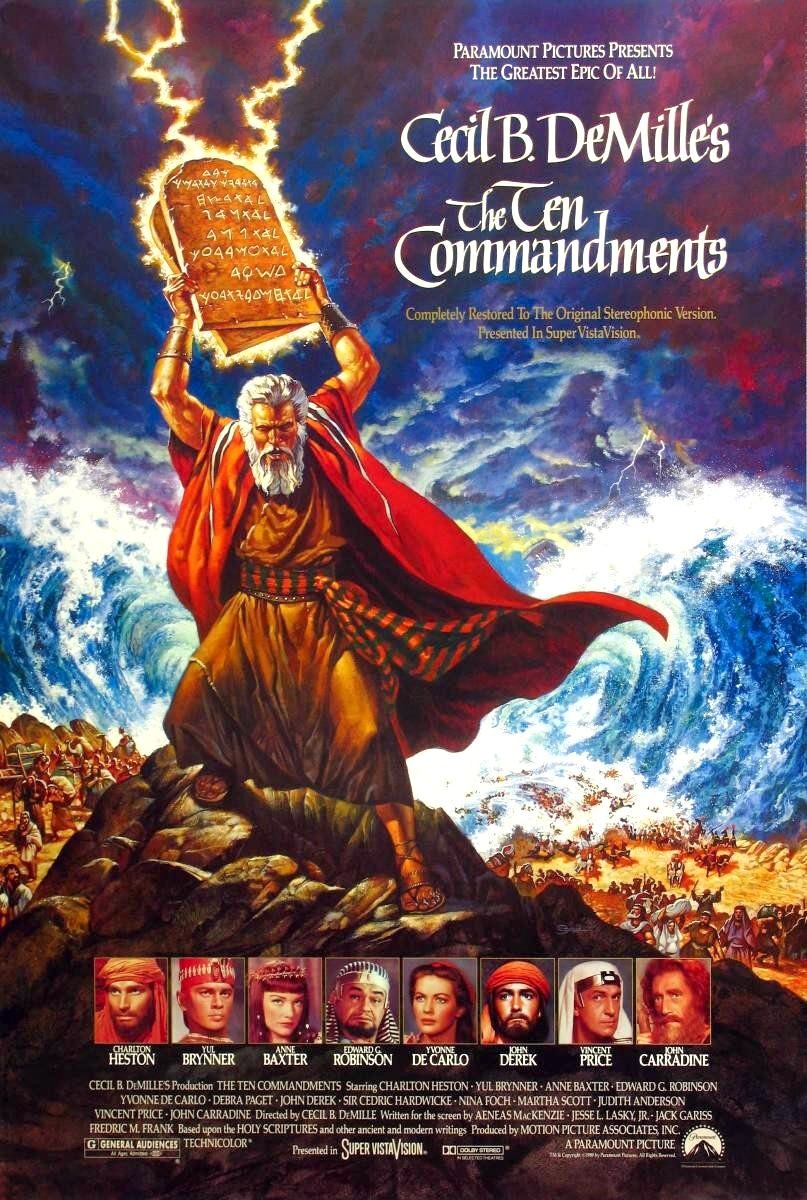
From this Sunday’s Old Testament reading, Exodus 20:1-17…
The Bible readings for Sunday, March 8, are Exodus 20:1-17, Psalm 19, 1 Corinthians 1:18-25, and John 2:13-22. For the full readings see the Third Sunday in Lent. Here are some highlights.
In Exodus 20:1-17, Moses set out the Ten Commandments the first time. (He did a second edition in Deuteronomy. I.e., the “Ten Commandments appear twice in the Hebrew Bible, first at Exodus 20:1-17, and then at Deuteronomy 5:4-21.”) See Ten Commandments – Wikipedia:
The Ten Commandments, also known as the Decalogue, are a set of biblical principles relating to ethics and worship, which play a fundamental role in Judaism and Christianity. They include instructions to worship only God and to keep the sabbath; as well as prohibitions against idolatry, blasphemy, murder, theft, dishonesty, and adultery.
I wrote about the Ten Commandments in “Exodus: G&K,” the movie, On arguing with God, and On Moses and “illeism.” The latter post asked the musical question, “What did Moses know, and when did he know it?” (Alluding to a similar question asked during the Senate Watergate hearings in 1973, but that’s a whole ‘nuther story altogether…) That post also discussed illeism, the practice of “referring to oneself in the third person instead of first person.”
And just as an aside, such illeism has been used as a a stylistic device in literature:
Julius Caesar used the device in his Commentaries about the Gallic Wars, while Xenophon of Athens – from whom the term xenophobia derives – used it in Anabasis, “‘one of the great adventures in human history…'”
See On Moses, which noted that he used that same style in writing the Torah.
Turning to Psalm 19, I talked about it in The Psalms up to December 7. I noted that Psalm 19 is “widely considered to be a ‘masterpiece of poetic literature,'” and that C. S. Lewis – who wrote The Chronicles of Narnia – considered it to be “the greatest poem in the Psalter and one of the greatest lyrics in the world.” See also Psalm 19 – Wikipedia, the free encyclopedia.
Verse 12 asks, “Who can tell how often he offends? Cleanse me from my secret faults.” I addressed that subject – “secret” or unknown sins – in On Ecclesiasticus (NOT “Ecclesiastes”), which cited Ecclesiasticus 5:5: “Do not be so sure of forgiveness that you add sin to sin.” The post also discussed “Holier than thou”, along with self-righteousness and hypocrisy.
See Psalms to December 7. And now, turning to the New Testament reading…
The Apostle Paul began his 1st Letter to the Corinthians 1:18-25, “The message about the cross is foolishness to those who are perishing, but to us who are being saved it is the power of God.” He then rendered what the International Bible Commentary called a “very free rendering of the LXX [Septuagint] translation” of Isaiah 29:14, to wit: “I will destroy the wisdom of the wise, and the discernment of the discerning I will thwart.” (See also 1st Corinthians 1:19 Parallel.)
Paul ended the reading by noting that “God’s foolishness is wiser than human wisdom, and God’s weakness is stronger than human strength.”
The Gospel reading, John 2:13-22, tells about Jesus cleansing the temple, after arming Himself with a whip of cords. This episode is “in all four canonical gospels of the New Testament:”
The narrative of the “Cleansing of the Temple” tells of Jesus and the money changers… In this Gospel episode Jesus and his disciples travel to Jerusalem for Passover, where he expels the money changers from the Temple, accusing them of turning the Temple into a den of thieves through their commercial activities. In the Gospel of John Jesus refers to the Temple as “my Father’s house…” Some Christians think this is the only account of Jesus using physical force in any of the Gospels.
After the incident the disciples remembered Psalm 69:10, “Zeal for your house has eaten me up,” as detailed in On the psalms up to September 28. The reading ended with Jesus promising to “raise this temple” in three days. The “powers that be” thought that He was talking about the actual, physical Temple in Jerusalem, “but He was speaking of the temple of his body.”

The upper image is courtesy of The Ten Commandments (1956 film) – Wikipedia. The caption: “The artist’s rendering of Charlton Heston as Moses was bulked up to modern physique standards when the DVD was released.”
The lower image is courtesy of Cleansing of the Temple – Wikipedia, the free encyclopedia. The caption: “Christ Driving the Money Changers from the Temple, London version, by El Greco.”